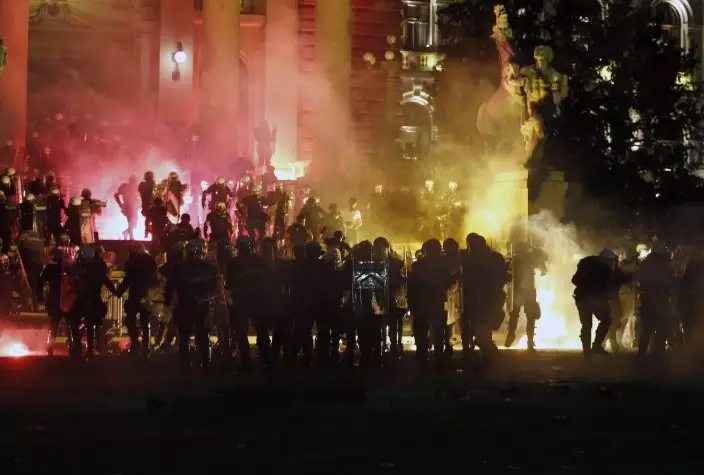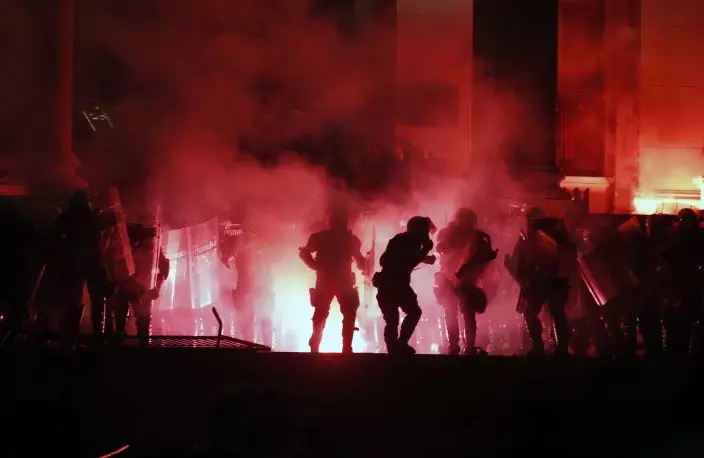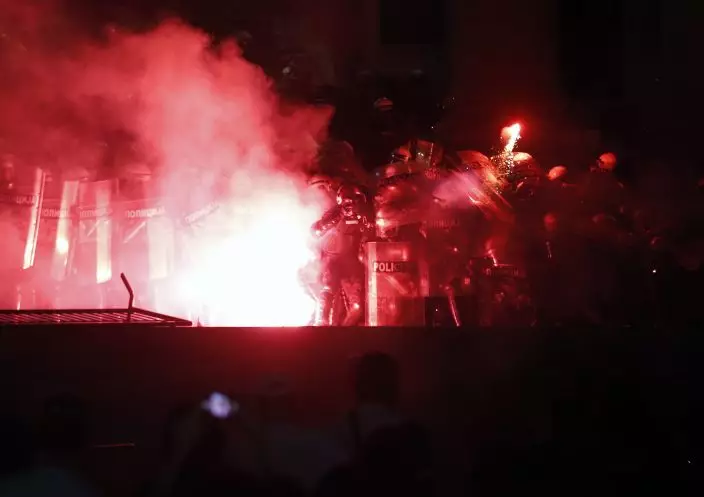Thousands of people in Serbia have been holding protests against the country’s president and his government in what was initially triggered by his plans to reintroduce lockdown measures to contain the coronavirus outbreak in the Balkan country.
Many in Serbia accuse increasingly authoritarian President Aleksandar Vucic of letting the virus crisis spin out of control in order to hold a parliamentary election on June 21 that tightened the ruling party’s grip on power.
Vucic has denied this although authorities had relaxed the rules on mass gatherings prior to the vote, allowing crowds at soccer games and tennis matches, nightclubs, restaurants and weddings.

Protesters clash with riot police on the steps of the Serbian parliament during a protest in Belgrade, Serbia, Friday, July 10 2020. Hundreds of demonstrators tried to storm Serbia's parliament on Friday, clashing with police who fired tear gas during the fourth night of protests against the president's increasingly authoritarian rule. The protests started on Tuesday when President Aleksandar Vucic announced that Belgrade would be placed under a new three-day lockdown following a second wave of confirmed coronavirus infections. (AP PhotoDarko Vojinovic)
Some of the demonstrations turned violent, with protesters trying to storm the parliament building in the capital, Belgrade.
The protesters, who have been defying an anti-virus ban on gatherings of more than 10 people, threw bottles, rocks and flares at police who were guarding the parliament building, and police responded with tear gas to disperse the angry crowds.
The protests, which started in Belgrade but later spread to several other Serbia cities, are considered the most intense since the overthrow of former Serbian strongman Slobodan Milosevic who was also unseated in a popular rebellion in October 2000.

Protesters clash with riot police on the steps of the Serbian parliament during a protest in Belgrade, Serbia, Friday, July 10 2020. Hundreds of demonstrators tried to storm Serbia's parliament on Friday, clashing with police who fired tear gas during the fourth night of protests against the president's increasingly authoritarian rule. (AP PhotoDarko Vojinovic)
WHAT TRIGGERED THE PROTESTS?
Last week’s demonstrations were at first driven by frustration over renewed lockdown measures to contain the pandemic, but soon evolved into anti-government rallies with participants demanding Vucic’s resignation.
The protests initially started July 7 when the president announced that Belgrade would be placed under a new three-day lockdown following a second wave of confirmed coronavirus infections.

Protesters clash with riot police on the steps of the Serbian parliament during a protest in Belgrade, Serbia, Friday, July 10 2020. Hundreds of demonstrators tried to storm Serbia's parliament on Friday, clashing with police who fired tear gas during the fourth night of protests against the president's increasingly authoritarian rule. The protests started on Tuesday when President Aleksandar Vucic announced that Belgrade would be placed under a new three-day lockdown following a second wave of confirmed coronavirus infections. (AP PhotoDarko Vojinovic)
They have continued even though Vucic suspended his plans to enforce the lockdown. Instead, his government has banned gatherings of more than 10 people in the capital.
Without clear leadership or a unifying message, the gatherings quickly attracted different groups, ranging from far-right and anti-vaccination groups to nationalists claiming Vucic wants to “betray” the Serbian cause and “sell off” Kosovo — the former Serbian province which they consider the cradle of Serbian medieval state and religion — in exchange for the country’s membership in the European Union.
The main opposition parties allege that Vucic and his secret service have used far-right groups to infiltrate the protests to hijack and weaken the uprising. The opposition says this has been done to distract the population from the main purpose of the demonstrations — protesting against Vucic's coronavirus policies. The president has denied this.
Because of a drop in the number of citizens that have gathered during the weekend, these nationalist groups have gained in prominence.
WHAT WAS THE PRESIDENT’S REACTION?
Vucic and other Serbian officials have denounced the protests as an attempt to overthrow the government and weaken his position in EU-mediated negotiations on Kosovo, the former province whose 2008 declaration of independence Belgrade doesn't recognize.
Vucic said he’s not afraid that he could lose political power amid the protests and expressed his fear about the spread of the virus by the demonstrators.
He pledged the state will curb the unrest, urging his followers not to confront the demonstrators. He denounced the protesters as “hooligans” and “sons of tycoons” who want to take power without elections.
WHAT WAS THE POLICE REACTION?
Police reacted to the attacks with a heavy hand, brutally beating up protesters and arresting several dozen, some of whom were swiftly sentenced to prison terms. Some were detained at their homes after being at the protests.
Footage from the rallies show a widespread violent crackdown against protesters in Serbia’s capital, Belgrade, and other major towns across the country which left dozens of people injured. Reporters covering the protests weren't spared from attacks by police or right-wing groups.
Videos on social media appeared to show police severely beating up protesters.
In one, a bystander was seen being hit and kicked by several officers and dumped on the sidewalk, seemingly unconscious. Another showed police officers hitting people sitting peacefully on a park bench, and in yet another plainclothes people were beating and kicking and stepping on the head of a man lying on the floor. The authenticity of the videos couldn't be independently verified.
Rights watchdog Amnesty International blamed the police for applying “heavy-handed measures” against demonstrators.
“Images of Serbian police firing tear gas and stun grenades indiscriminately into the crowd, and of protesters and bystanders being charged by mounted police and beaten by police in riot gear, raise serious concerns,” rights group Amnesty International said in a statement.
IS THERE A RUSSIAN CONNECTION?
Pro-government tabloids in Serbia have claimed that Russian intelligence services were behind the unrest, which they say is designed to destabilize the country as Western efforts mount to negotiate a deal normalizing relations with Kosovo.
Serbia is a rare Russian ally in Europe with historically close Slavic ties. The country is bidding to join the EU after years of crisis and wars in the 1990s. Nationalist and far-right groups in Serbia are opposed to EU membership and want closer ties with Russia instead.
The Russian Foreign Ministry has vehemently denied any involvement in the latest protests in Serbia.


